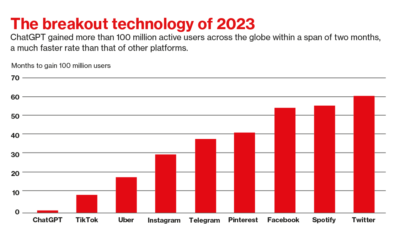Politics
Understanding the Financial Market Life Cycle
Published
2 years agoon
By
Drew Simpson
Don’t Panic — Bear Markets are Just a Normal Part of the Market Life Cycle as an Investor
After reaching highs in early January, the S&P 500 and NASDAQ both plunged into a bear market territory, falling more than 20% to close out the first half of 2022. This tumble prompted renewed interest in an age-old question: Are we in a bear market? And if so, what does that mean for the individual investor?
Bear markets are generally defined as a drop of 20% or more in an index or security
Some bear markets are short-lived, as we experienced in 2020 with the COVID-19 lockdown, but some can be prolonged, as we saw with the Great Recession.
Following the six-month tumble to start this year, investors are trying to determine whether security prices will continue falling or if the worst is behind them. Regardless, this news serves as a critical reminder that stock prices don’t simply go up in perpetuity, and a bear market can present investors with new opportunities.
There has been no shortage of bad news for investors in the first half of 2022
Between supply chain issues, labor shortages, spikes in home prices and rent, and the highest inflation in 40 years, investors have to worry about various risk factors to develop a sound investment strategy.
None of us has a crystal ball to peer into the future of the financial markets, so it doesn’t matter that investors can’t predict the future but rather how we respond to market turbulence and build our portfolios.
The Economic and Financial Markets Cycle
Behavioral finance experts tell us that investors often let emotions cloud their best judgment and drive decision-making that is ultimately at odds with their long-term investing goals when it comes to the economy and financial market cycles.
When markets shift, the temptation is for investors to buy high and then panic and sell low. The debate over whether or not we are currently in a recession is a popular topic on social media. Still, financial markets have already priced this economic contraction for equities and fixed-income securities. The real question is how long these headwinds will persist.
Investors have more access to important information about the economy and financial markets
Today, investors have more access to important information about the economy and financial markets than ever before. In addition, it has never been easier to begin trading with numerous financial technology “apps” offering easy access to trading platforms. Consequently, investors are much more likely to react — positively or negatively — to any market changes.
Experiencing nearly 13 years of market growth, many of today’s investors may have felt invincible, buying stocks or trading options before our economy turned toward recession.
Every investment may have seemed like a winner, and many people were making money. However, the extended market cycle — and historically unprecedented fiscal and monetary policy stimulus during the COVID lockdown — created false expectations. People thought that the good times would continue for the foreseeable future.
Unfortunately, many overconfident investors bought high — just as the market crested
“Don’t fight the Fed” is a commonly used phrase on Wall Street. During the peak of the COVID-19 pandemic, unprecedented fiscal and monetary policies created a significant tailwind for most investments.
Congress enacted laws to put money in the hands of companies and American consumers. As the federal government handed out stimulus money, the Federal Reserve had accommodative policies that pumped cash into the economy as well.
These policies extended the bull market through the pandemic’s early days, and many investors did great.
But “Don’t Fight The Fed” works in both directions. First, the Federal Reserve has pivoted to restrictive policies to try to contain inflation and is now aggressively raising interest rates.
As of this writing, inflation is still at the highest level since the early 1980s, so the Fed is likely to continue to use all weapons in its arsenal in an attempt to tamp down inflation.
With the significant pullback in equities in the first half, particularly in most of the large-cap technology names, fear is causing many retail investors to sell, thereby locking in their losses and limiting their ability to grow their money over the long term.
A Normal Part of the Ebb and Flow of the Market Cycle
Coming down from an extended bull market period, the market’s pullback from historical highs makes it difficult for most investors to understand that these ebbs and flows are a normal part of the market cycle. No market goes up forever, and stocks will eventually have to be repriced.
That said, no one knows what will happen in the markets day-to-day, so trying to time the market is often a fool’s errand — and panic is not a strategy. As long as you have the appropriate diversification in your portfolio based on your individual investment objectives, don’t panic! Instead, sit back, relax and let the market do its thing.
Diversify and Invest According to Your Timeline
A recession is also a normal part of the life cycle. As long as your portfolio is diversified and you’re investing according to the timeline for your specific goals, there is no reason to panic.
Investing to achieve various goals — whether to retire comfortably in 20 years, go on vacation next year or purchase a new vehicle within the next five years — can be pretty straightforward. The key is ensuring your investment allocations sync with the timelines for each goal. In addition, focus on the long term, diversify and avoid products with high fee structures.
Look at your time horizon for the objective for which you’re saving and invest according to that horizon. For example, if you are many years from retirement, your retirement allocation will probably be close to 100% in equities.
Your money should be in a well-diversified portfolio so you can walk away and forget about it.
The money you’re investing for your vacation next year will be mainly in cash and cash equivalents like certificates of deposit (CDs). However, for goals that may be a few years out, you should utilize fixed-income securities — perhaps fixed-income exchange-traded funds.
As your goal investment horizons get longer, equities become a more prominent and more significant part of that portfolio. But always be aware that if you are selling investments supporting long-term goals, you are effectively locking in the loss.
Diversification is Key to Any Long-Term Investment Strategy
Instead of having all your money in one security, it’s essential to allocate investments to each goal you’re saving toward. You might get rich if you’re investing all of your money into one stock, option, or cryptocurrency. But for everyone on social media bragging about how much money they made off one trade, for example, thousands of others lost everything.
As a result, investors need to understand the difference between investing and having a solid investing strategy versus speculation or gambling.
Do you understand the investment you are considering and why it is going higher or lower? While numerous media outlets now focus on short-term trading, investors must realize that this is speculation, not investing.
Long-Term Investing Can and Should be Easy to Understand
Taking a long-term approach to investment should not be stressful, nor should it take a lot of effort or management. But developing a long-term investment strategy isn’t the hard part — it’s sticking to that plan in the face of tumultuous market environments.
As investors, we should feel good about putting our money to work for us, not stressed out, panicky, or constantly checking for updates.
Stay away from get-rich-quick schemes and short-term speculation that is difficult to understand. As Jack Bogle once said, “investors win; speculators lose.”
Featured Image Credit: Photo by Liza Summer; Pexels; Thank you!
Chad Butler
Chad is the President & COO of Marygold & Co. He brings over 20 years of experience in card issuer processing/program management, banking and electronic payments industries coupled with a strong entrepreneurial background. Chad is excited to introduce a next generation financial technology (fintech) platform to the United States that redefines expectations.
You may like
-


I received the new gene-editing drug for sickle cell disease. It changed my life.
-


Finding value in generative AI for financial services
-


The Download: the origins of life, and building Facebook’s AI empire
-


The Biggest Questions: How did life begin?
-


Unlocking the Power of Financial Data: How Data Annotation Enhance Decision-Making
-


10 Financial Planning Mistakes Couples Make When Shacking Up
Politics
Fintech Kennek raises $12.5M seed round to digitize lending
Published
7 months agoon
10/11/2023By
Drew Simpson
London-based fintech startup Kennek has raised $12.5 million in seed funding to expand its lending operating system.
According to an Oct. 10 tech.eu report, the round was led by HV Capital and included participation from Dutch Founders Fund, AlbionVC, FFVC, Plug & Play Ventures, and Syndicate One. Kennek offers software-as-a-service tools to help non-bank lenders streamline their operations using open banking, open finance, and payments.
The platform aims to automate time-consuming manual tasks and consolidate fragmented data to simplify lending. Xavier De Pauw, founder of Kennek said:
“Until kennek, lenders had to devote countless hours to menial operational tasks and deal with jumbled and hard-coded data – which makes every other part of lending a headache. As former lenders ourselves, we lived and breathed these frustrations, and built kennek to make them a thing of the past.”
The company said the latest funding round was oversubscribed and closed quickly despite the challenging fundraising environment. The new capital will be used to expand Kennek’s engineering team and strengthen its market position in the UK while exploring expansion into other European markets. Barbod Namini, Partner at lead investor HV Capital, commented on the investment:
“Kennek has developed an ambitious and genuinely unique proposition which we think can be the foundation of the entire alternative lending space. […] It is a complicated market and a solution that brings together all information and stakeholders onto a single platform is highly compelling for both lenders & the ecosystem as a whole.”
The fintech lending space has grown rapidly in recent years, but many lenders still rely on legacy systems and manual processes that limit efficiency and scalability. Kennek aims to leverage open banking and data integration to provide lenders with a more streamlined, automated lending experience.
The seed funding will allow the London-based startup to continue developing its platform and expanding its team to meet demand from non-bank lenders looking to digitize operations. Kennek’s focus on the UK and Europe also comes amid rising adoption of open banking and open finance in the regions.
Featured Image Credit: Photo from Kennek.io; Thank you!
Radek Zielinski
Radek Zielinski is an experienced technology and financial journalist with a passion for cybersecurity and futurology.
Politics
Fortune 500’s race for generative AI breakthroughs
Published
7 months agoon
10/11/2023By
Drew Simpson
As excitement around generative AI grows, Fortune 500 companies, including Goldman Sachs, are carefully examining the possible applications of this technology. A recent survey of U.S. executives indicated that 60% believe generative AI will substantially impact their businesses in the long term. However, they anticipate a one to two-year timeframe before implementing their initial solutions. This optimism stems from the potential of generative AI to revolutionize various aspects of businesses, from enhancing customer experiences to optimizing internal processes. In the short term, companies will likely focus on pilot projects and experimentation, gradually integrating generative AI into their operations as they witness its positive influence on efficiency and profitability.
Goldman Sachs’ Cautious Approach to Implementing Generative AI
In a recent interview, Goldman Sachs CIO Marco Argenti revealed that the firm has not yet implemented any generative AI use cases. Instead, the company focuses on experimentation and setting high standards before adopting the technology. Argenti recognized the desire for outcomes in areas like developer and operational efficiency but emphasized ensuring precision before putting experimental AI use cases into production.
According to Argenti, striking the right balance between driving innovation and maintaining accuracy is crucial for successfully integrating generative AI within the firm. Goldman Sachs intends to continue exploring this emerging technology’s potential benefits and applications while diligently assessing risks to ensure it meets the company’s stringent quality standards.
One possible application for Goldman Sachs is in software development, where the company has observed a 20-40% productivity increase during its trials. The goal is for 1,000 developers to utilize generative AI tools by year’s end. However, Argenti emphasized that a well-defined expectation of return on investment is necessary before fully integrating generative AI into production.
To achieve this, the company plans to implement a systematic and strategic approach to adopting generative AI, ensuring that it complements and enhances the skills of its developers. Additionally, Goldman Sachs intends to evaluate the long-term impact of generative AI on their software development processes and the overall quality of the applications being developed.
Goldman Sachs’ approach to AI implementation goes beyond merely executing models. The firm has created a platform encompassing technical, legal, and compliance assessments to filter out improper content and keep track of all interactions. This comprehensive system ensures seamless integration of artificial intelligence in operations while adhering to regulatory standards and maintaining client confidentiality. Moreover, the platform continuously improves and adapts its algorithms, allowing Goldman Sachs to stay at the forefront of technology and offer its clients the most efficient and secure services.
Featured Image Credit: Photo by Google DeepMind; Pexels; Thank you!
Deanna Ritchie
Managing Editor at ReadWrite
Deanna is the Managing Editor at ReadWrite. Previously she worked as the Editor in Chief for Startup Grind and has over 20+ years of experience in content management and content development.
Politics
UK seizes web3 opportunity simplifying crypto regulations
Published
7 months agoon
10/10/2023By
Drew Simpson
As Web3 companies increasingly consider leaving the United States due to regulatory ambiguity, the United Kingdom must simplify its cryptocurrency regulations to attract these businesses. The conservative think tank Policy Exchange recently released a report detailing ten suggestions for improving Web3 regulation in the country. Among the recommendations are reducing liability for token holders in decentralized autonomous organizations (DAOs) and encouraging the Financial Conduct Authority (FCA) to adopt alternative Know Your Customer (KYC) methodologies, such as digital identities and blockchain analytics tools. These suggestions aim to position the UK as a hub for Web3 innovation and attract blockchain-based businesses looking for a more conducive regulatory environment.
Streamlining Cryptocurrency Regulations for Innovation
To make it easier for emerging Web3 companies to navigate existing legal frameworks and contribute to the UK’s digital economy growth, the government must streamline cryptocurrency regulations and adopt forward-looking approaches. By making the regulatory landscape clear and straightforward, the UK can create an environment that fosters innovation, growth, and competitiveness in the global fintech industry.
The Policy Exchange report also recommends not weakening self-hosted wallets or treating proof-of-stake (PoS) services as financial services. This approach aims to protect the fundamental principles of decentralization and user autonomy while strongly emphasizing security and regulatory compliance. By doing so, the UK can nurture an environment that encourages innovation and the continued growth of blockchain technology.
Despite recent strict measures by UK authorities, such as His Majesty’s Treasury and the FCA, toward the digital assets sector, the proposed changes in the Policy Exchange report strive to make the UK a more attractive location for Web3 enterprises. By adopting these suggestions, the UK can demonstrate its commitment to fostering innovation in the rapidly evolving blockchain and cryptocurrency industries while ensuring a robust and transparent regulatory environment.
The ongoing uncertainty surrounding cryptocurrency regulations in various countries has prompted Web3 companies to explore alternative jurisdictions with more precise legal frameworks. As the United States grapples with regulatory ambiguity, the United Kingdom can position itself as a hub for Web3 innovation by simplifying and streamlining its cryptocurrency regulations.
Featured Image Credit: Photo by Jonathan Borba; Pexels; Thank you!
Deanna Ritchie
Managing Editor at ReadWrite
Deanna is the Managing Editor at ReadWrite. Previously she worked as the Editor in Chief for Startup Grind and has over 20+ years of experience in content management and content development.
